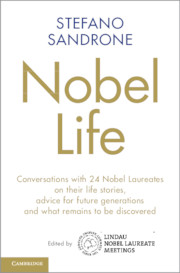 Nobel Life
Nobel Life Book contents
- Nobel Life
- Nobel Life
- Copyright page
- Dedication
- Contents
- Foreword
- Preface
- 1 The Periodic Table
- 2 Eureka and Disney World
- 3 Flying High
- 4 I’ll Show You What a Woman Can Do
- 5 Toys’ Stories
- 6 Clarity
- 7 Mentoring
- 8 A Stroke of Colour
- 9 Impact Factors
- 10 Know Thyself
- 11 Memory and Vision
- 12 Words and People
- 13 Christmas and Carol
- 14 Rocket Science
- 15 The Big Bang Practice
- 16 Houston, We Have a Solution and Many Questions
- 17 À la Recherche of Space and Time
- 18 Leadership and Society
- 19 Of Kings and Cabbages
- 20 Foreword to the Future
- Acknowledgements
- Appendix: List of Nobel Laureates
- Credits
- Index
13 - Christmas and Carol
Published online by Cambridge University Press: 03 June 2021
- Nobel Life
- Nobel Life
- Copyright page
- Dedication
- Contents
- Foreword
- Preface
- 1 The Periodic Table
- 2 Eureka and Disney World
- 3 Flying High
- 4 I’ll Show You What a Woman Can Do
- 5 Toys’ Stories
- 6 Clarity
- 7 Mentoring
- 8 A Stroke of Colour
- 9 Impact Factors
- 10 Know Thyself
- 11 Memory and Vision
- 12 Words and People
- 13 Christmas and Carol
- 14 Rocket Science
- 15 The Big Bang Practice
- 16 Houston, We Have a Solution and Many Questions
- 17 À la Recherche of Space and Time
- 18 Leadership and Society
- 19 Of Kings and Cabbages
- 20 Foreword to the Future
- Acknowledgements
- Appendix: List of Nobel Laureates
- Credits
- Index
Summary
Human DNA is packed into forty-six chromosomes inside the cells of our body. At each end of the chromosome are the so-called telomeres: if the chromosome is a shoelace, the telomeres would be the protective plastic ends at the end of the shoelace. Cell divisions are essential to life, and they continuously take place in our body. However, the more the cell divides, the more telomeres are shortened, and the more the cell ages. In return, an enzyme called telomerase ‘rebuilds’ the telomeres, thus restoring the protection of the chromosome and delaying cellular senescence. The relationship between telomeres and telomerase is a delicate equilibrium. You won the Nobel Prize in 2009 for the discovery of ‘how chromosomes are protected by telomeres and the enzyme telomerase’.
- Type
- Chapter
- Information
- Nobel LifeConversations with 24 Nobel Laureates on their Life Stories, Advice for Future Generations and What Remains to be Discovered, pp. 135 - 144Publisher: Cambridge University PressPrint publication year: 2021
